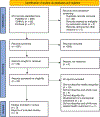A comparison of conceptual frameworks to examine health inequities in End-of-Life care
- PMID: 35909090
- PMCID: PMC9887096
- DOI: 10.1111/jan.15393
A comparison of conceptual frameworks to examine health inequities in End-of-Life care
Abstract
Aims: To discuss existing conceptual frameworks that can be applied to the examination of health inequities in end-of-life care and related health outcomes. We used the Fawcett and Desanto-Madeya evaluation technique modified by the National Institute on Minority Health and Health Disparities Research Framework to include individual, interpersonal, community, and societal levels of influence.
Design: Discussion paper.
Data sources: We performed a systematic review of PubMed, CINAHL and Embase for conceptual frameworks of health inequities in end-of-life care and health outcomes published as of February 2022.
Implications for nursing: There is a strong need for research that can address multiple factors influencing end-of-life care inequities and health outcomes. To mitigate the complex nature of social determinants of health and structural inequities, researchers, clinicians, educators and administrators should have solid conceptualizations of these multi-level factors. Based on sound and comprehensive frameworks, nurses with interdisciplinary partnerships can promote health equity with a broader health care scope through addressing social determinants of health.
Conclusion: We identified and reviewed three frameworks. We concluded all three frameworks have the potential for use in the examination of health inequities in end-of-life care and health outcomes. However, the Conceptual Framework of Minority Access to End-of-Life Care was more applicable to diverse studies and settings when adapted to include fundamental characteristics such as sex and gender.
Impact: Despite the substantial rise in end-of-life care delivery, health inequities persist in end-of-life care access and utilization. Though some studies have been conducted to promote health equity by addressing social determinants of health, progress is hampered by their complex and multi-faceted nature. Through a concrete conceptual framework, researchers can comprehensively examine multi-level factors influencing health inequities in end-of-life care.
No patient or public contribution: This discussion paper focused on reviewing existing evidence.
Keywords: conceptual frameworks; end-of-life care; health inequities; nursing/nurses; social determinants of health; theoretical models.
© 2022 John Wiley & Sons Ltd.
Conflict of interest statement
CONFLICT OF INTEREST
There are no conflicts of interest.
Figures




Similar articles
-
A framework for addressing health inequities in sexual and gender diverse populations by nurses.Nurs Outlook. 2022 Jul-Aug;70(4):651-663. doi: 10.1016/j.outlook.2022.04.001. Epub 2022 Jul 5. Nurs Outlook. 2022. PMID: 35798586
-
Student and educator experiences of maternal-child simulation-based learning: a systematic review of qualitative evidence protocol.JBI Database System Rev Implement Rep. 2015 Jan;13(1):14-26. doi: 10.11124/jbisrir-2015-1694. JBI Database System Rev Implement Rep. 2015. PMID: 26447004
-
Evaluation of conceptual frameworks applicable to the study of isolation precautions effectiveness.J Adv Nurs. 2015 Oct;71(10):2279-92. doi: 10.1111/jan.12718. Epub 2015 Jul 14. J Adv Nurs. 2015. PMID: 26179813 Free PMC article. Review.
-
Conceptual framework of equity-focused implementation research for health programs (EquIR).Int J Equity Health. 2019 May 31;18(1):80. doi: 10.1186/s12939-019-0984-4. Int J Equity Health. 2019. PMID: 31151452 Free PMC article.
-
Equity First: Conceptualizing a Normative Framework to Assess the Role of Preemption in Public Health.Milbank Q. 2020 Mar;98(1):131-149. doi: 10.1111/1468-0009.12444. Epub 2020 Jan 17. Milbank Q. 2020. PMID: 31951048 Free PMC article. Review.
Cited by
-
An evaluation of conceptual frameworks to improve reproductive health outcomes among women with physical disabilities.J Adv Nurs. 2025 Apr;81(4):2136-2147. doi: 10.1111/jan.16304. Epub 2024 Jul 5. J Adv Nurs. 2025. PMID: 38969486 Free PMC article.
-
A Qualitative Exploration of Healthcare Workers' Experiences of End of Life Care for People With an Intellectual Disability.J Adv Nurs. 2025 Jul;81(7):3972-3986. doi: 10.1111/jan.16556. Epub 2024 Nov 6. J Adv Nurs. 2025. PMID: 39503296 Free PMC article.
References
-
- Alligood MR(2014). Nursing theorists and their work
-
- Bazargan M, & Bazargan-Hejazi S(2021). Disparities in palliative and hospice care and completion of advance care planning and directives among non-Hispanic blacks: A scoping review of recent literature. The American Journal of Hospice & Palliative Care, 38(6), 688–718. 10.1177/1049909120966585 - DOI - PMC - PubMed
Publication types
MeSH terms
Grants and funding
LinkOut - more resources
Full Text Sources

